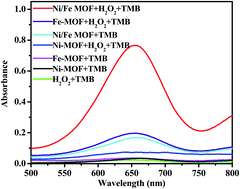2D bimetallic Ni/Fe MOF nanosheet composites as a peroxidase-like nanozyme for colorimetric assay of multiple targets†
Abstract
In this contribution, 2D Ni/Fe MOF nanosheets were synthesized by a simple two-step ultrasound strategy at room temperature, i.e. the 2D Ni-MOF with a lamellar structure was first synthesized by the top-down ultrasonic assisted stripping route, followed by introducing Fe3+ ions as a metal node and terephthalic acid as an organic ligand to form 2D Ni/Fe MOF nanosheets that exhibited weak oxidase-like and strong peroxidase-like properties. Relative to that of the single metal Ni-MOF and Fe-MOF, the peroxidase-mimicking capability of the 2D Ni/Fe MOF nanosheets increased by over 14-fold and 3-fold, respectively. Reactive oxygen trials indicated that the 2D Ni/Fe MOF nanosheets can efficiently catalyze the decomposition of H2O2 to generate the ˙OH and O2˙− radicals, which can oxidize TMB to oxTMB from colorless to blue. The kinetic trial demonstrated the high affinity of the 2D Ni/Fe MOF nanosheet to H2O2 with a Km of 0.037 mM, which was 100 times lower than that of HRP. These impressive characteristics are likely related to the good dispersion of the in situ formed Fe MOF in the 2D Ni-MOF nanosheet structure with coordinatively unsaturated metal sites. This allows the 2D Ni/Fe MOF nanosheets to expose more active metal sites and to enhance the intrinsic catalytic activity of each site due to the synergistic interaction between the two metals. Interestingly, glutathione can obviously restrict the peroxidase-like activity of the 2D Ni/Fe MOF nanosheet, while the inhibited TMB oxidation can be restored upon further introducing Hg2+ ions due to the high and specific affinity of Hg2+ to thiol groups in glutathione. Based on the above facts, the 2D Ni/Fe MOF nanozyme was used to construct a nanoplatform to determine multiple targets, i.e. H2O2, glutathione and Hg2+. The 2D Ni/Fe MOF nanozyme-based colorimetric assay exhibits a linear response to H2O2, glutathione and Hg2+ ions over the 0.01–100 μM, 0.02–100 μM, and 100 nM to 200 μM ranges, respectively. The limits of detection (3σ) for the determination of H2O2, glutathione and Hg2+ are 10 nM, 10 nM, and 100 nM, respectively. This method was used to determinate the content of Hg2+ ions in real water samples.



 Please wait while we load your content...
Please wait while we load your content...